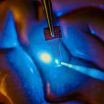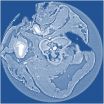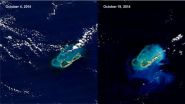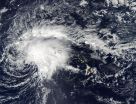(Press-News.org) VIDEO:
Scientists at the US Department of Energy's Ames Laboratory modeled the 'passing probability' of molecules within the narrow pores of mesoporous nanoparticles. This understanding will help determine the optimal diameter...
Click here for more information.
Scientists at the U.S. Department of Energy's Ames Laboratory have developed deeper understanding of the ideal design for mesoporous nanoparticles used in catalytic reactions, such as hydrocarbon conversion to biofuels. The research will help determine the optimal diameter of channels within the nanoparticles to maximize catalytic output.
Porous nanoparticles are lab-created tiny spheres that incorporate even tinier parallel channels or pores. In catalytic processes, each channel within a particle is lined with catalytic sites that convert a reactant to a product. What's appealing about porous nanoparticles is that the walls of the pores provide significant surface area to support catalytic sites within a super-small sphere. And, as one might expect, the more pores, the more surface area, the better the catalytic reaction.
"Downside is that when the catalytic sites are within narrow pores, as is the case with mesoporous nanoparticles, the entire reaction, including the movement of reactants and products has to happen within the narrow channel," said Jim Evans, a scientist at Ames Laboratory who led the research. "Just like anyone who has found themselves trying to move around a crowded grocery store aisle, it's not always so easy to move past others in a very narrow space."
So, the optimal design for mesoporous nanoparticles hinges on the diameter of the individual channels: narrow enough to fit as many pores in each particle as possible to maximize the number of catalytic sites -- but wide enough for catalytic products and reactants to easily squeeze by each other and efficiently complete the reaction. To determine this "sweet spot" for channel diameter, scientists must better understand how molecules move past each other within the channel.
"In particular, it is helpful to know how often a nearby pair of reactant and product molecules pass by each other versus how often they separate from one another. Determining this 'passing probability' for different pore diameters and various relevant molecular shapes helps determine just how narrow channels can be before the catalytic output is reduced," said Evans.
Evans and his collaborators ran millions of simulations trials for pairs of sphere-shaped molecules and pairs of more irregularly-shaped molecules. These enabled precise determination of passing probability behavior for narrow pores.
"However, simulation becomes demanding and results less reliable for realistic irregular-shaped molecules with many rotational degrees of freedom. Also, just running simulations does not necessarily provide a deep understanding as to what features control behavior," said Evans.
So, he brought together expertise at Ames Laboratory in both theoretical chemistry and applied mathematics to determine and implement the best theoretical and modeling tools to get more reliable results and deeper insights into how the passing probability falls to zero as the channel size narrows.
"It was the integrated combination of intensive simulations and novel analytic theory that together provided a substantial advance in our understanding of these important molecular passing processes. With this kind of insight, in principle, porous nanoparticle systems can be optimized," said Evans.
INFORMATION:
Results were reported in Physical Review Letters: http://journals.aps.org/prl/abstract/10.1103/PhysRevLett.113.038301
This research is supported by the U.S. Department of Energy Office of Science.
Ames Laboratory is a U.S. Department of Energy Office of Science national laboratory operated by Iowa State University. Ames Laboratory creates innovative materials, technologies and energy solutions. We use our expertise, unique capabilities and interdisciplinary collaborations to solve global problems. DOE's Office of Science is the single largest supporter of basic research in the physical sciences in the United States, and is working to address some of the most pressing challenges of our time.
ATLANTA—Animal-assisted therapy can reduce symptoms of anxiety and loneliness among college students, according to researchers at Georgia State University, Idaho State University and Savannah College of Art and Design. Their findings are published in the latest issue of the Journal of Creativity in Mental Health.
The researchers provided animal-assisted therapy to 55 students in a group setting at a small arts college in the Southeast. They found a 60 percent decrease in self-reported anxiety and loneliness symptoms following animal-assisted therapy, in which a ...
MADISON, Wis. — Developing invisible implantable medical sensor arrays, a team of University of Wisconsin-Madison engineers has overcome a major technological hurdle in researchers' efforts to understand the brain.
The team described its technology, which has applications in fields ranging from neuroscience to cardiac care and even contact lenses, in the Oct. 20 issue of the online journal Nature Communications.
Neural researchers study, monitor or stimulate the brain using imaging techniques in conjunction with implantable sensors that allow them to continuously ...
WASHINGTON D.C. Oct. 21, 2014 -- The most obvious effects of too much sun exposure are cosmetic, like wrinkled and rough skin. Some damage, however, goes deeper—ultraviolet light can damage DNA and cause proteins in the body to break down into smaller, sometimes harmful pieces that may also damage DNA, increasing the risk of skin cancer and cataracts. Understanding the specific pathways by which this degradation occurs is an important step in developing protective mechanisms against it.
Researchers from the École Polytechnique Fédérale de Lausanne ...
By analysing DNA extracted from the petrous bones of skulls of ancient Europeans, scientists have identified that these peoples remained intolerant to lactose (natural sugar in the milk of mammals) for 5,000 years after they adopted agricultural practices and 4,000 years after the onset of cheese-making among Central European Neolithic farmers.
The findings published online in the scientific journal Nature Communications (21 Oct) also suggest that major technological transitions in Central Europe between the Neolithic, Bronze Age and Iron Age were also associated with ...
WASHINGTON, D.C., October 21, 2014 -- X-ray phase tomography is an imaging technique that uses penetrating X-rays to create volumetric views through "slices" or sections of soft biological tissues, such as tumors, and it offers strongly enhanced contrast compared to conventional CT scans. Yet scientists still do not know which X-ray phase tomography methods are best suited to yield optimized results for a wide variety of conditions.
To answer this question, a large group of researchers in Europe set out to compare three different X-ray phase tomography methods at the ...
WASHINGTON, D.C., October 21, 2014 -- Hikers are generally advised that the weight of the packs they carry should correspond to their own size, with smaller individuals carrying lighter loads. Although petite backpackers might appreciate the excuse to hand off heavier gear to the larger members of the group, it turns out that they may not need the help.
While leading students on extended backpacking trips for Outward Bound, Kansas State University physics professor Michael O'Shea noticed that some of the smaller students could comfortably carry a greater pack weight than ...
VIDEO:
Chapman University has initiated the first comprehensive nationwide study on what strikes fear in Americans in the first of what is a planned annual study. The Chapman Survey on American...
Click here for more information.
ORANGE, Calif. – Chapman University has initiated the first comprehensive nationwide study on what strikes fear in Americans in the first of what is a planned annual study. According to the Chapman poll, the number one fear in America today ...
A team of researchers led by NOAA's Office of National Marine Sanctuaries have discovered two significant vessels from World War II's Battle of the Atlantic. The German U-boat 576 and the freighter Bluefields were found approximately 30 miles off the coast of North Carolina. Lost for more than 70 years, the discovery of the two vessels, in an area known as the Graveyard of the Atlantic, is a rare window into a historic military battle and the underwater battlefield landscape of WWII.
"This is not just the discovery of a single shipwreck," said Joe Hoyt, a NOAA sanctuary ...
NASA's Aqua and Terra satellites captured before and after images of Bermuda and surrounding waters before and after Hurricane Gonzalo struck the island on Oct. 17. The images revealed how Gonzalo stirred up the sediment from the ocean bottom.
The MODIS instrument or Moderate Resolution Imaging Spectroradiometer that flies aboard NASA's Aqua and Terra satellites provided imagery of Bermuda and the stirred sediment. In a comparison of imagery before and after Hurricane Gonzalo passed, the after image showed sediment streaming east and south of Bermuda. The MODIS instrument ...
Slow-moving Tropical Storm Ana was still affecting parts of Hawaii on Oct. 20 when NASA's Aqua satellite passed overhead from its orbit in space. Imagery from Aqua showed that wind shear was affecting the storm.
The Moderate Resolution Imaging Spectroradiometer or MODIS instrument aboard NASA's Aqua satellite captured a visible picture of Tropical Storm Ana over Hawaii on Oct. 20 at 23:55 UTC (7:55 p.m. EDT). The image showed that most of the clouds and showers were north and east of the center of circulation, pushed away from the center by strong southwesterly wind ...










